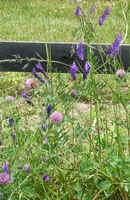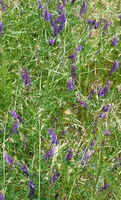 |
 |
Common Name: Spring Vetch or Cow Vetch
Scientific Name: Vicia cracca
Family Name: Leguminosae
Mills River, North Carolina
May 29, 2002
 |
 |
Tufted vetch, also known as cow vetch, is widely scattered along the Parkway and is more likely to be found along the northern section in Virginia. It is a climbing plant with gray-green leaves and a long, one-sided, crowded spike of tubular, blue to pink, pea-like flowers. The flowers hang downward on a long stalk. The leaves are pinnately compound, with eight to ten pairs of narrow, bristly tipped, 1-inch-long leaflets. Look for a pair of tendrils at the end of each stalk. Usually found in waste places, in old fields, and along roadsides. May-July [Alderman, J. Anthony, Wildflowers of the Blue Ridge Parkway. The University of North Carolina Press, Chapel Hill, 1997]
In late spring go to sunny fields or roadsides and look for the distinctive leaves of vetch. They are pinnately compound, which means that the whole leaf is composed of many little leaflets arranged in pairs along a central vein. At the base of each compound leaf there are two tiny, sharp projections. These are called stipules. They vary in size and shape in the various species of vetches and can be a good clue to identification. Their function in tufted vetch is unknown. . . . At the tips of the leaves you will see several tendrils. . . . When the tip of the tendril comes in contact with another plant, it curls around it. Then the rest of the tendril begins to coil like a spring and pull the vetch plant toward its support. Tufted vetch does interesting things underground as well. If you carefully dig up some of the plant, you will first see little white dots on the smallest rootlets. These are called nodules and contain a bacteria that takes nitrogen from the air and makes it into a form that is usable by the plant. Thus, vetches enrich the soil in which they live. . . . You will also find thickened portions, which are rhizomes, which grow out from the parent plant and produce new shoots nearby. In fall they are white and have buds for the next year's plants at their tips. Once we were walking by our field on a late summer day that was hot and dry. We kept hearing rustlings among the grasses but couldn't figure out where they were coming from. We went in the direction of the rustlings and still had trouble pinpointing the occurrence. Then we realized that we were in the middle of a patch of tufted vetch with matured fruits. The clusters of small pods were tan and dry, and as we touched some with our fingers they explosively split open, each half of the pod forming a tight curl. You couldn't see the seeds as they were shot off into the grasses, but you could hear them. This same method of seed dispersal is used by many of the legumes. [Stokes, Donald and Lillian, Stokes Nature Guides: A Guide to Enjoying Wildflowers. Little, Brown and Company, Boston, 1985]
January February March April May June July August September October November December
Alphabetical Listings -- A B C D, E F G H I, J, K L M N, O P Q, R S T U, V W X, Y, Z
Family Listings -- A B C D, E F G H I, J, K L M N, O P Q, R S T U, V W X, Y, Z
Genus Listings -- A B C D, E F G H I, J, K L M N, O P Q, R S T U, V W X, Y, Z